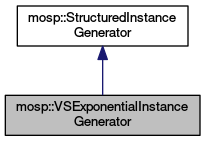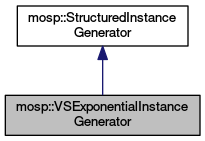An variable size "exponential" instance generator. More...
#include <generator.h>


Public Member Functions | |
| VSExponentialInstanceGenerator (int apps, int posts, double Density, double lambda) | |
| Create a new generator. More... | |
| VSExponentialInstanceGenerator (int apps, int posts, double Density, double lambda, int seed) | |
| Create a new generator. More... | |
| void | GenerateGML (std::ostream &o) |
| Generate a random structured instance in GML format. More... | |
| void | GenerateGraph (leda::graph &G, leda::list< leda::node > &A, leda::list< leda::node > &B, leda::node_map< int > &capacity, leda::edge_map< int > &rank) |
| Generate a random structured instance. More... | |
| int | NumPosts () const |
| int | NumApplicants () const |
Detailed Description
An variable size "exponential" instance generator.
The variable size random instance generator, while very similar to the fixed size generator , tries to capture a slightly different situation. Let  be a strict total order, as in the previous generator. We again partition the posts into clusters of exponentially increasing size. Now, however, clusters are similar but different for each applicant.
be a strict total order, as in the previous generator. We again partition the posts into clusters of exponentially increasing size. Now, however, clusters are similar but different for each applicant.
The generator has the following parameters: (a) number of applicants  and posts
and posts  , (b) instance density parameter
, (b) instance density parameter  , and (c) parameter
, and (c) parameter  controlling the distribution of posts into clusters. We construct the preference list of an applicant
controlling the distribution of posts into clusters. We construct the preference list of an applicant  as follows. Our goal is to add an edge from
as follows. Our goal is to add an edge from  to the first
to the first  posts. We initially add edge
posts. We initially add edge  with rank 1. When adding edge
with rank 1. When adding edge  we decide the rank based on the parameter
we decide the rank based on the parameter  . We choose with probability
. We choose with probability  whether to increase the rank by one or use the same rank as edge
whether to increase the rank by one or use the same rank as edge  .
.
Constructor & Destructor Documentation
|
inline |
Create a new generator.
- Parameters
-
apps Number of applicants  .
. posts Number of posts  .
. Density Density parameter  .
. lambda Parameter  .
.
|
inline |
Create a new generator.
- Parameters
-
apps Number of applicants  .
. posts Number of posts  .
. Density Density parameter  .
. lambda Parameter 
seed A seed for the random number generator
Member Function Documentation
|
inherited |
Generate a random structured instance in GML format.
- Parameters
-
o Output the GML graph in this stream
|
inherited |
Generate a random structured instance.
- Parameters
-
G The graph to return A The list of applicants B The list of posts capacity The node capacities rank The edge ranks
|
inlineinherited |
Number of applicants that the resulting instance will have.
|
inlineinherited |
Number of posts that the resulting instance will have.
 1.8.11
1.8.11